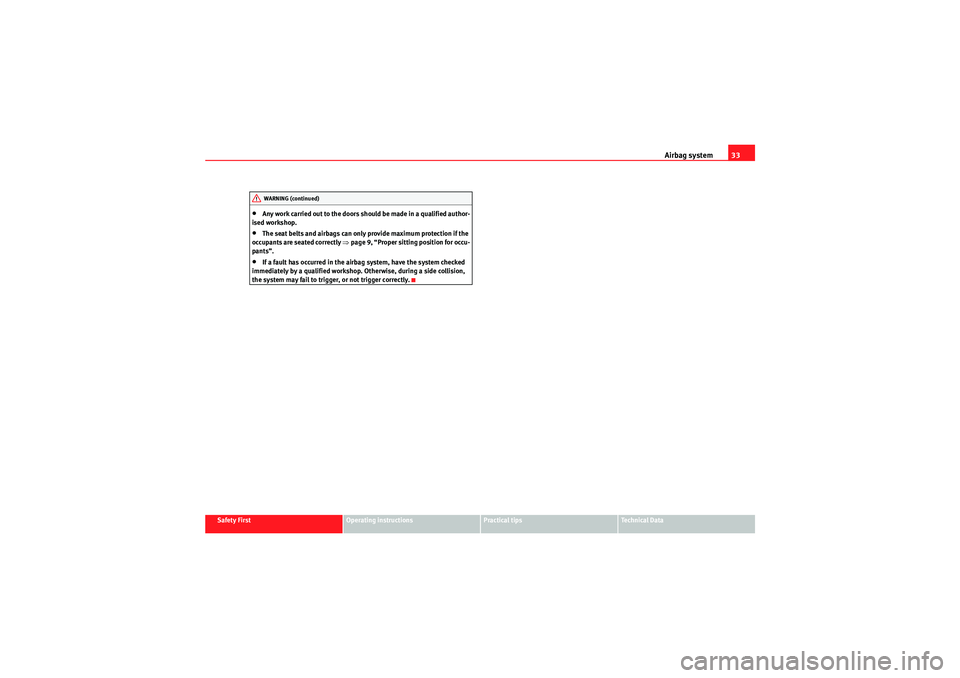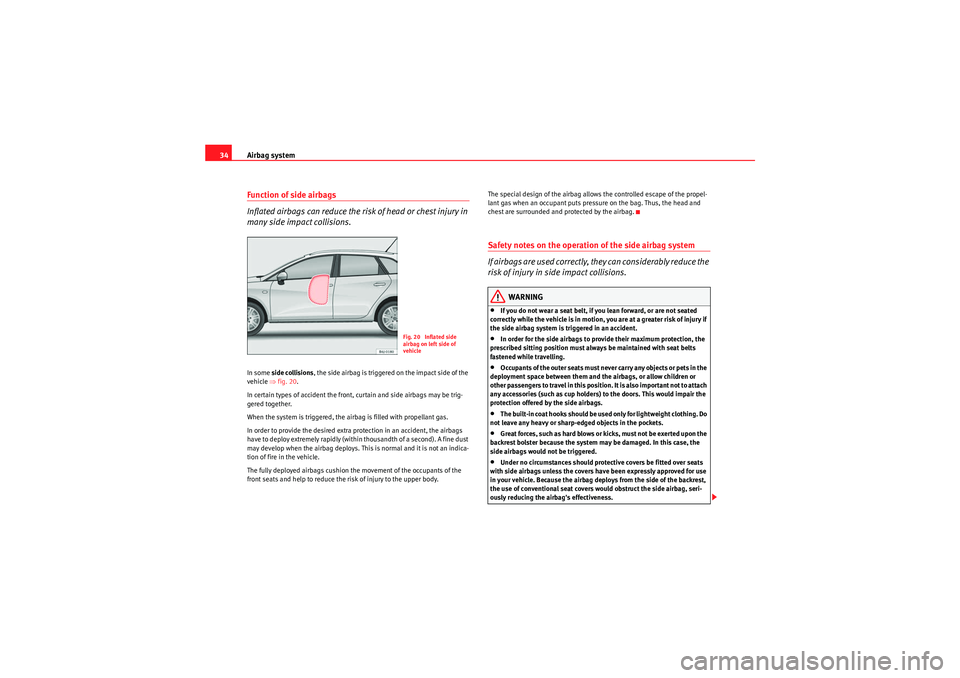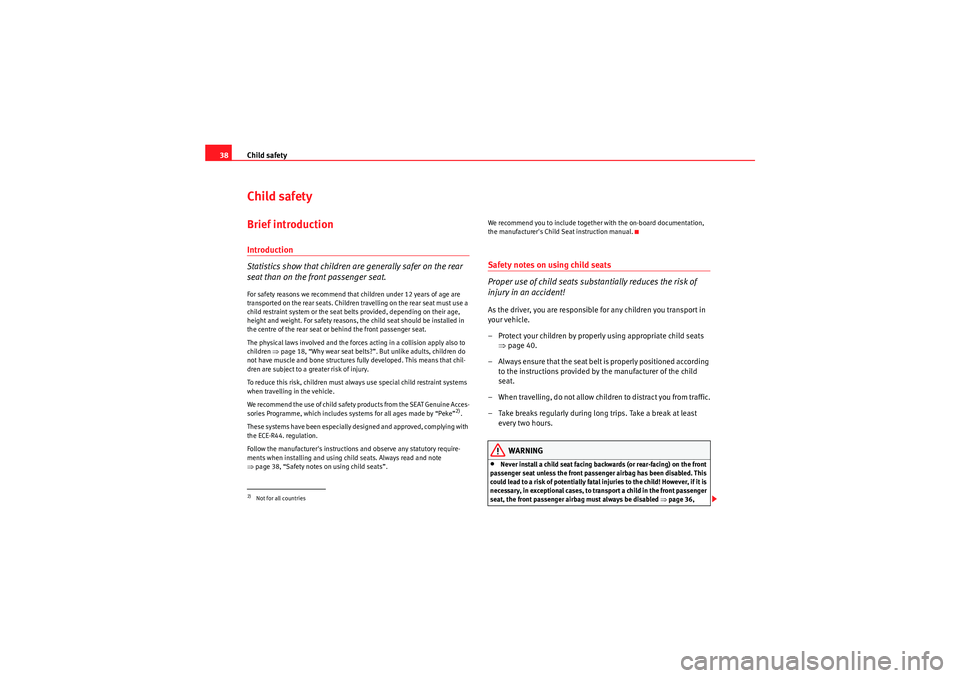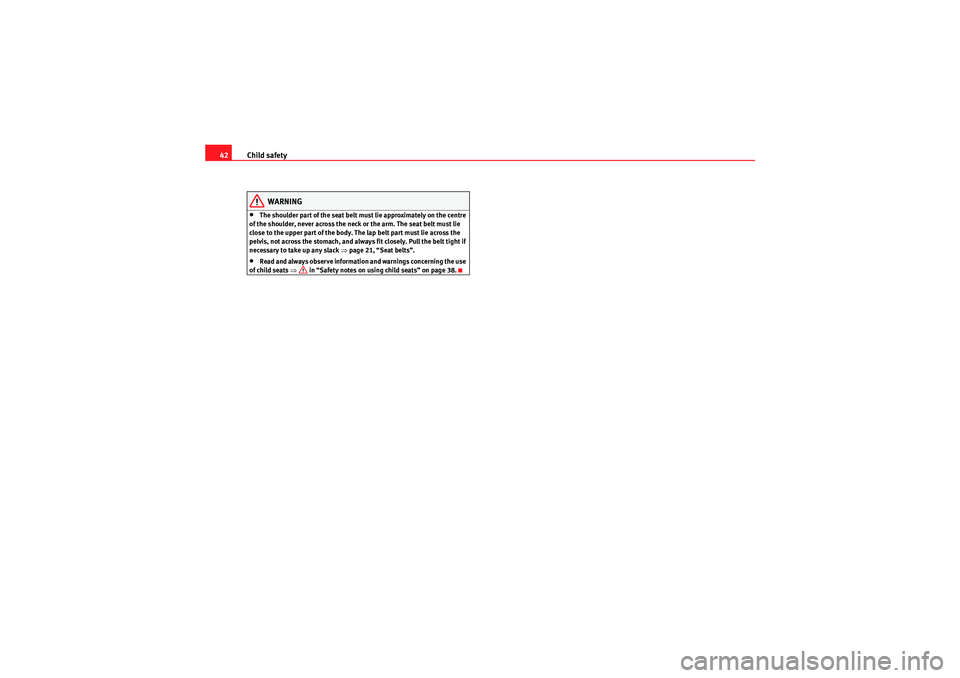2009 Seat Ibiza ST belt
[x] Cancel search: beltPage 33 of 250

Airbag system
32Side airbagsDescription of side airbags
The airbag system is not a substitute for the seat belts.The side airbags are located in the driver seat and front passenger seat back-
rests ⇒fig. 19 . The locations are identified by the text “AIRBAG” in the upper
region of the backrests.
Together with the seat belts, the side airbag system gives the front seat occu-
pants additional protection for the upper body in the event of a severe side
collision ⇒ page 34, “Safety notes on the operation of the side airbag
system”.
In a side collision, the side airbags reduce the risk of injury to passengers on
the front seats to the areas of the body facing the impact. In addition to their
normal function of protecting the occupants in a collision, the seat belts also
hold the passengers on the front seats in a position where the side airbags
can provide maximum protection. The airbag system is not a substitute for seat belts, but it is an integral part
of the vehicle's overall passive safety system. Please bear in mind that the
airbag system can only work effectively when the occupants are wearing their
seat belts. For this reason, it is most important to wear the seat belts at all
times, not only because this is required by law in most countries, but also as
a contribution to your own safety
The side airbag system will not be triggered if:
•the ignition is switched off,•there is a minor side collision,•there is a frontal collision,•there is a rear-end collision,•the vehicle turns over.
The main parts of the airbag system are:•an electronic control and monitoring system (control unit),•the side airbags in the sides of the backrests of the front seats,•a warning lamp
in the instrument panel ⇒page 27.
The airbag system operation is monitored electronically. The airbag warning
lamp will light up for approx. 4 seconds every time the ignition is switched on
(self-diagnosis).
WARNING
•Never drive the vehicle if the interior panels have been removed.•Never drive if the interior door panels have been removed or if the
panels have not been correctly fitted.•Never drive the vehicle if the loudspeakers in the door panels have
been removed, unless the holes left by the loudspeakers have been
correctly closed.•Always check that the openings are closed or covered if loudspeakers
or other equipment are fitted in the interior door panels.
Fig. 19 Side airbag in
driver seat
Ibiza ST_EN.book Seite 32 Dienstag, 12. Januar 2010 4:03 16
Page 34 of 250

Airbag system33
Safety First
Operating instructions
Practical tips
Technical Data
•Any work carried out to the doors should be made in a qualified author-
ised workshop.•The seat belts and airbags can only provide maximum protection if the
occupants are seated correctly ⇒ page 9, “Proper sitting position for occu-
pants”.•If a fault has occurred in the airbag system, have the system checked
immediately by a qualified workshop. Otherwise, during a side collision,
the system may fail to trigger, or not trigger correctly.WARNING (continued)
Ibiza ST_EN.book Seite 33 Dienstag, 12. Januar 2010 4:03 16
Page 35 of 250

Airbag system
34Function of side airbags
Inflated airbags can reduce the risk of head or chest injury in
many side impact collisions.In some side collisions , the side airbag is triggered on the impact side of the
vehicle ⇒fig. 20 .
In certain types of accident the front, curtain and side airbags may be trig-
gered together.
When the system is triggered, the airbag is filled with propellant gas.
In order to provide the desired extra protection in an accident, the airbags
have to deploy extremely rapidly (within thousandth of a second). A fine dust
may develop when the airbag deploys. This is normal and it is not an indica-
tion of fire in the vehicle.
The fully deployed airbags cushion the movement of the occupants of the
front seats and help to reduce the risk of injury to the upper body. The special design of the airbag allows the controlled escape of the propel-
lant gas when an occupant puts pressure on the bag. Thus, the head and
chest are surrounded and protected by the airbag.
Safety notes on the operation of the side airbag system
If airbags are used correctly, they can considerably reduce the
risk of injury in side impact collisions.
WARNING
•If you do not wear a seat belt, if you lean forward, or are not seated
correctly while the vehicle is in motion, you are at a greater risk of injury if
the side airbag system is triggered in an accident.•In order for the side airbags to provide their maximum protection, the
prescribed sitting position must always be maintained with seat belts
fastened while travelling.•Occupants of the outer seats must never carry any objects or pets in the
deployment space between them and the airbags, or allow children or
other passengers to travel in this position. It is also important not to attach
any accessories (such as cup holders) to the doors. This would impair the
protection offered by the side airbags.•The built-in coat hooks should be us ed only for lightweight clothing. Do
not leave any heavy or sharp-edged objects in the pockets.•Great forces, such as hard blows or kicks, must not be exerted upon the
backrest bolster because the system may be damaged. In this case, the
side airbags would not be triggered.•Under no circumstances should protective covers be fitted over seats
with side airbags unless the covers have been expressly approved for use
in your vehicle. Because the airbag deploys from the side of the backrest,
the use of conventional seat covers would obstruct the side airbag, seri-
ously reducing the airbag's effectiveness.
Fig. 20 Inflated side
airbag on left side of
vehicle
Ibiza ST_EN.book Seite 34 Dienstag, 12. Januar 2010 4:03 16
Page 39 of 250

Child safety
38Child safetyBrief introductionIntroduction
Statistics show that children are generally safer on the rear
seat than on the front passenger seat.For safety reasons we recommend that children under 12 years of age are
transported on the rear seats. Children travelling on the rear seat must use a
child restraint system or the seat belts provided, depending on their age,
height and weight. For safety reasons, the child seat should be installed in
the centre of the rear seat or behind the front passenger seat.
The physical laws involved and the forces acting in a collision apply also to
children ⇒page 18, “Why wear seat belts?”. But unlike adults, children do
not have muscle and bone structures fully developed. This means that chil-
dren are subject to a greater risk of injury.
To reduce this risk, children must always use special child restraint systems
when travelling in the vehicle.
We recommend the use of child safety products from the SEAT Genuine Acces-
sories Programme, which includes systems for all ages made by “Peke”
2).
These systems have been especially designed and approved, complying with
the ECE-R44. regulation.
Follow the manufacturer's instructions and observe any statutory require-
ments when installing and using child seats. Always read and note
⇒ page 38, “Safety notes on using child seats”. We recommend you to include together with the on-board documentation,
the manufacturer's Child Seat instruction manual.
Safety notes on using child seats
Proper use of child seats substantially reduces the risk of
injury in an accident!As the driver, you are responsible for any children you transport in
your vehicle.
– Protect your children by properly using appropriate child seats
⇒page 40.
– Always ensure that the seat belt is properly positioned according to the instructions provided by the manufacturer of the child
seat.
– When travelling, do not allow children to distract you from traffic.
– Take breaks regularly during long trips. Take a break at least
every two hours.
WARNING
•Never install a child seat facing backwards (or rear-facing) on the front
passenger seat unless the front passenger airbag has been disabled. This
could lead to a risk of potentially fatal injuries to the child! However, if it is
necessary, in exceptional cases, to transport a child in the front passenger
seat, the front passenger airbag must always be disabled ⇒page 36,
2)Not for all countries
Ibiza ST_EN.book Seite 38 Dienstag, 12. Januar 2010 4:03 16
Page 40 of 250

Child safety39
Safety First
Operating instructions
Practical tips
Technical Data
“Deactivating airbags*”. If the passenger seat has a height adjustment
option, move it to the highest position.
•For those vehicles that do not include a key lock switch to turn the
airbag off, an Authorised Service Centre must be consulted.•All passengers, especially children, must assume the proper sitting
position and be properly belted in while travelling.•Never hold children or babies on your lap, this can result in potentially
fatal injuries to the child!•Never allow a child to be transported in a vehicle without being properly
secured, or to stand up or kneel on a seat while travelling. In an accident,
the child could be flung through the vehicle, causing possibly fatal injuries
to themselves and to the other passengers.•If children assume an improper sitting position when the car is moving,
they expose themselves to greater risk of injury in the event of sudden
braking manoeuvre or in an accident. This is particularly important if the
child is travelling on the front passenger seat and the airbag system is trig-
gered in an accident; as this could cause serious injury or even death.•A suitable child seat can protect your child!•Never leave an unsupervised child alone on a child seat or in the
vehicle.•Depending on weather conditions, it may become extremely hot or cold
inside the vehicle. This can be fatal.•Children who are less than 1.5 metres tall must not wear a normal seat
belt without a child seat, as this could cause injuries to the abdominal and
neck areas during a sudden braking manoeuvre or in an accident.•Do not allow the seat belt to become twisted or jammed, or to rub on
any sharp edges.•Incorrectly worn seat belts can cause injuries even in a minor collision
or in sudden braking manoeuvres.
•The seat belt provides maximum protection only when the seat belt is
properly positioned ⇒page 21, “Seat belts”.•Only one child may occupy a child seat ⇒page 40, “Child seats”.
WARNING (continued)
WARNING (continued)
Ibiza ST_EN.book Seite 39 Dienstag, 12. Januar 2010 4:03 16
Page 41 of 250

Child safety
40Child seatsCategorisation of child seats into groups
Use only child seats that are officially approved and suitable
for the child.Child seats are subject to the regulation ECE-R 44. ECE-R. It means that:
Economic Commission for Europe Regulation
The child seats are grouped into 5 categories:
Group 0 : children up to 10 kg
Group 0+ : children up to 13 kg
Group 1 : from 9 to 18 kg
Group 2 : from 15 to 25 kg
Group 3 : from 22 to 36 kg
Child seats that have been tested and approved under the ECE R 44 standard
bear the test mark on the seat (the letter E in a circle with the test number
below it).
Group 0 and 0+ child seats
A suitable child seat and a correctly adjusted seat belt can
help you to protect your child.Group 0: For babies from about 9 months old and 10 kg in weight the most
suitable seats are those appearing in the illustration ⇒ fig. 23.
Group 0+: For babies from about 18 months old and 13 kg in weight the most
suitable seats are those appearing in the illustration ⇒fig. 23 .
Follow the manufacturer's instructions and observe any statutory require-
ments when installing and using child seats.
We recommend you to include together with the on-board documentation,
the manufacturer's Child Seat instruction manual.
WARNING
Read and always observe information and warnings concerning the use of
child seats ⇒ in “Safety notes on using child seats” on page 38.
Fig. 23 A group 0 rear-
facing child seat fitted on
the rear seat.
Ibiza ST_EN.book Seite 40 Dienstag, 12. Januar 2010 4:03 16
Page 42 of 250

Child safety41
Safety First
Operating instructions
Practical tips
Technical Data
Group 1 child seats
A suitable child seat and a correctly adjusted seat belt can
help you to protect your child.Child seats using the “ISOFIX” system or seats in which the child faces the
rear of the car are most appropriate for babies and small children weighing
between 9 and 18 kg.
Follow the manufacturer's instructions and observe any statutory require-
ments when installing and using child seats.
We recommend you to include together with the on-board documentation,
the manufacturer's Child Seat instruction manual.
WARNING
Read and always observe information and warnings concerning the use of
child seats ⇒ in “Safety notes on using child seats” on page 38.
Group 2 and 3 child seats
A suitable child seat and a correctly adjusted seat belt can
help you to protect your child.Follow the manufacturer's instructions and observe any statutory require-
ments when installing and using child seats.
We recommend you to include together with the on-board documentation,
the manufacturer's Child Seat instruction manual.
Group 2 child seats
Children under 7 years of age weighing between 15 and 25 kg are best
protected by group 2 child seats together with properly adjusted seat belts.
Group 3 child seats
Children over 7 years of age weighing between 22 and 36 kg but less than 1.5
metres tall are best protected by seat cushions with head restraints together
with properly worn seat belts ⇒fig. 25 .
Fig. 24 A category 1
forward-facing child seat
fitted on the rear seat.
Fig. 25 Forward-facing
child seat installed on rear
seat.
Ibiza ST_EN.book Seite 41 Dienstag, 12. Januar 2010 4:03 16
Page 43 of 250

Child safety
42
WARNING
•The shoulder part of the seat belt must lie approximately on the centre
of the shoulder, never across the neck or the arm. The seat belt must lie
close to the upper part of the body. The lap belt part must lie across the
pelvis, not across the stomach, and always fit closely. Pull the belt tight if
necessary to take up any slack ⇒page 21, “Seat belts”.•Read and always observe information and warnings concerning the use
of child seats ⇒ in “Safety notes on using child seats” on page 38.
Ibiza ST_EN.book Seite 42 Dienstag, 12. Januar 2010 4:03 16